The Ultimate Guide to Cycling the Dolomites
Everything you need to know to plan the perfect Dolomites cycling trip — routes, climbs, seasons, gear, logistics, and must-see places, all in one guide.

Quick Links
The Dolomites are, without exaggeration, one of the most epic cycling destinations on the planet.
Cyclists come here for the legendary Giro d’Italia passes, the razor-cut limestone peaks, the perfect tangle of switchbacks, and the unmistakable Alpine-meets-Italian atmosphere that makes every ride unforgettable.
In this Ultimate Guide to Cycling in the Dolomites, you’ll get everything you need to plan your dream cycling trip:
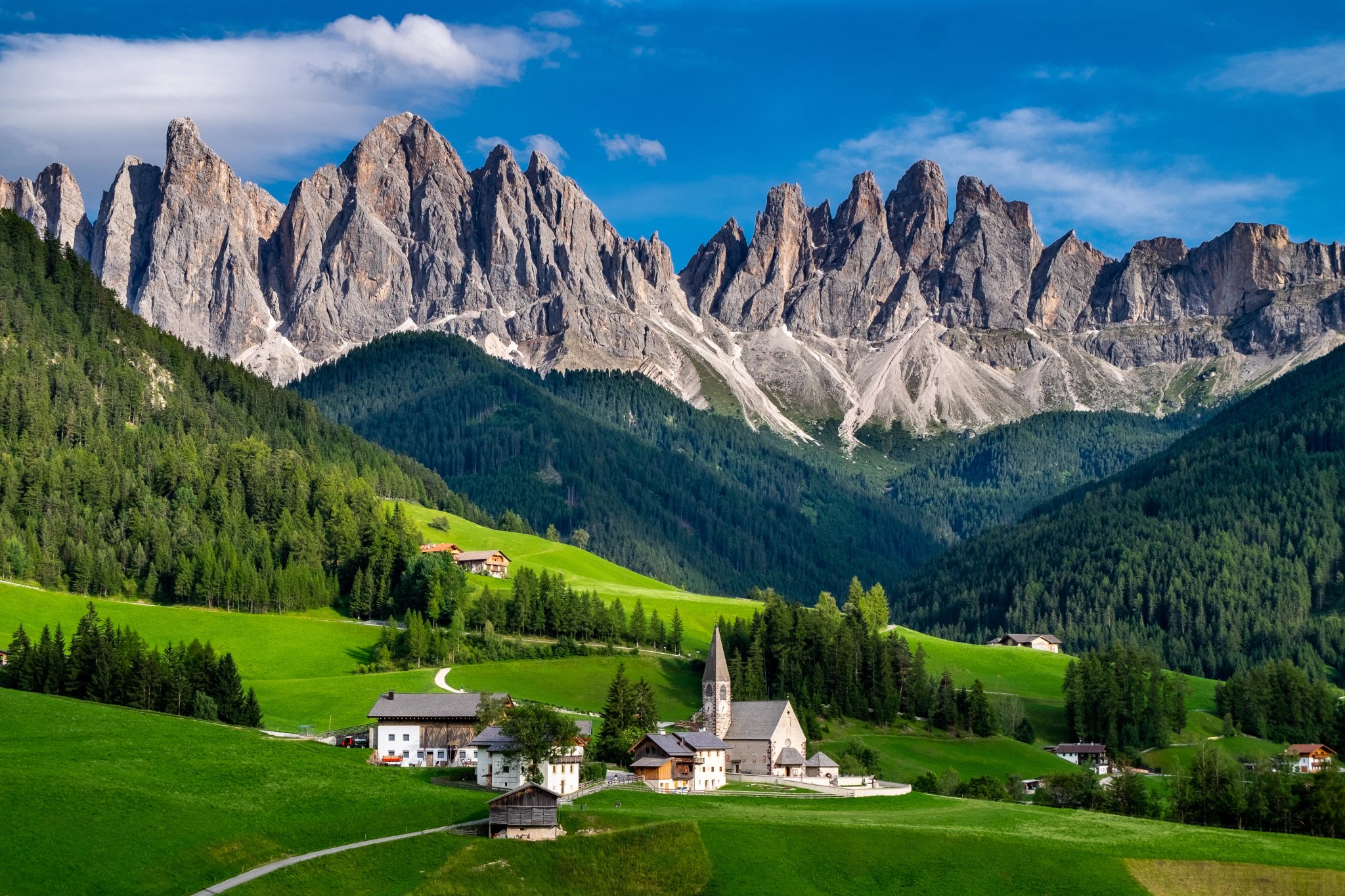
Overview of the Dolomites
The Dolomites are a remarkable mountain region in northeastern Italy, part of the Southern Limestone Alps and protected as a UNESCO World Heritage Site for their dramatic geology.
Spread across three regions, South Tyrol, Trentino, and Veneto, the Dolomites are not a single continuous chain but a constellation of several distinct mountain groups — the Sella, Marmolada, Tre Cime, Rosengarten, Pale di San Martino, and others — each rising sharply from deep valleys and creating the iconic landscapes the region is famous for.

Towering limestone spires, vertical cliffs, glowing pale rock, and high alpine meadows come together to form one of Europe’s most visually striking mountain environments.
A Glimpse into Cycling in the Dolomites
For cyclists, these geographical and geological characteristics define the entire riding experience. Because the mountains rise so abruptly from the valleys, many climbs begin almost the moment you leave town, offering little warm-up and lots of immediate elevation.
Most major passes sit between 1,800 and 2,400 metres, which means riders will experience significant altitude changes on every route, along with quick shifts in weather and temperature as they climb.
What to expect in short:
Steep gradients and rapid elevation gain right from the valley floor
Iconic switchbacks engineered with smooth, predictable curves
Beautifully surfaced mountain roads ideal for both climbing and descending
High-altitude passes with cooler temperatures and dramatic open views
Constant landscape changes — forests, meadows, rock towers — all in a single ride
Compared to other famous cycling regions:
vs. French Alps: Dolomites are steeper, punchier, and visually more dramatic.
vs. Pyrenees: Higher elevation, more varied landscapes, less remote but more structured tourism.
vs. Swiss Alps: More rugged and raw, with far more Giro-famous climbs.
This combination — density of climbs, beauty, accessibility, and culture — is why many cyclists consider the Dolomites the most spectacular cycling playground in Europe.
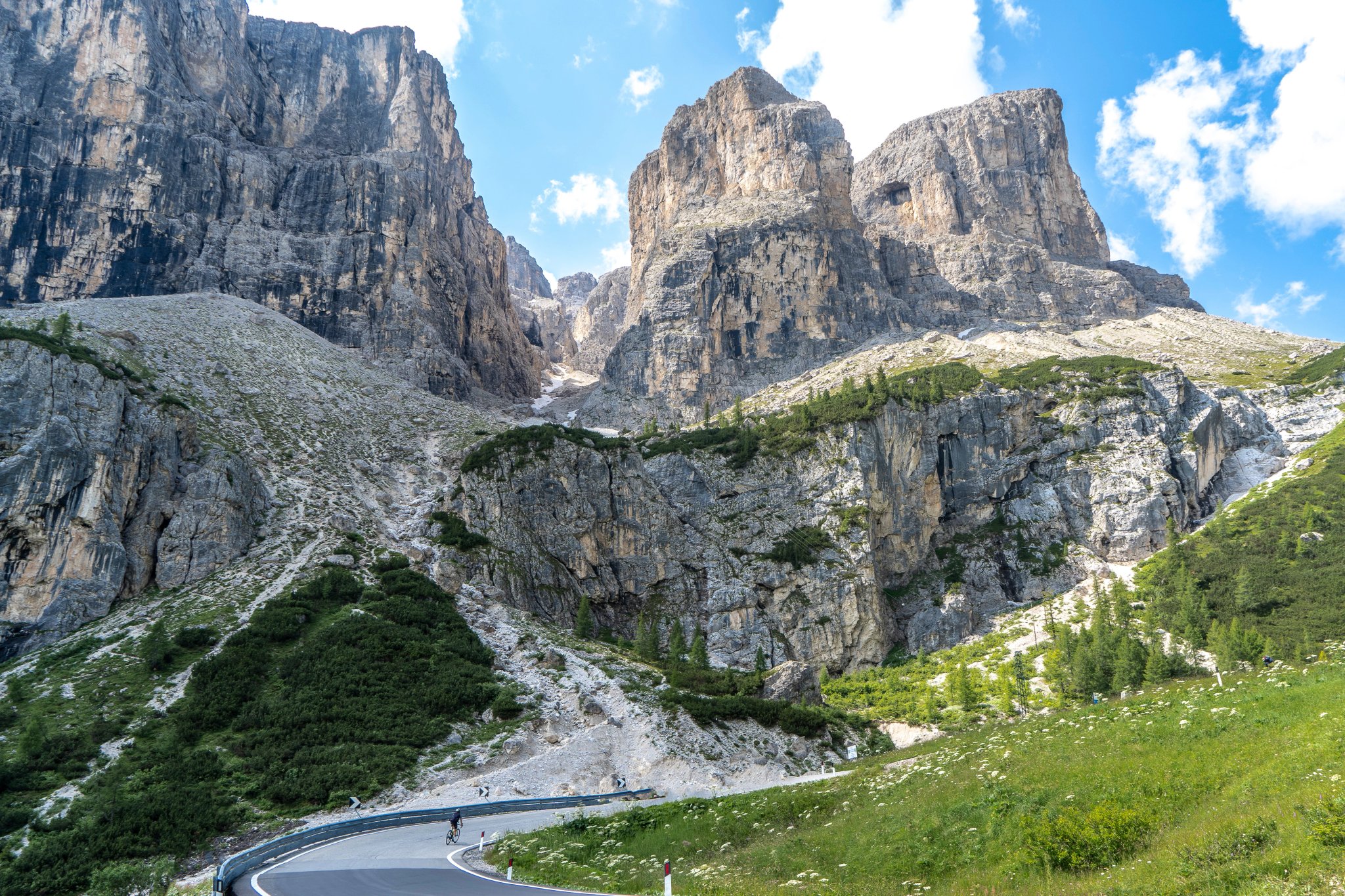
When to Go
The Dolomites have a true high-mountain climate, with warm clear summers, crisp shoulder seasons, and snowy winters. Because most iconic passes sit between 1,800–2,400 metres, the cycling season here is shorter — but the mid-season conditions are nothing short of spectacular.
Seasons at a Glance:
Late May–June: Start of the cycling season — high passes might still be closed due to snow
July–August: Peak season with fully open passes
September–October: Ideal late-season window
November–April: High passes are snow-covered and cycling isn’t possible
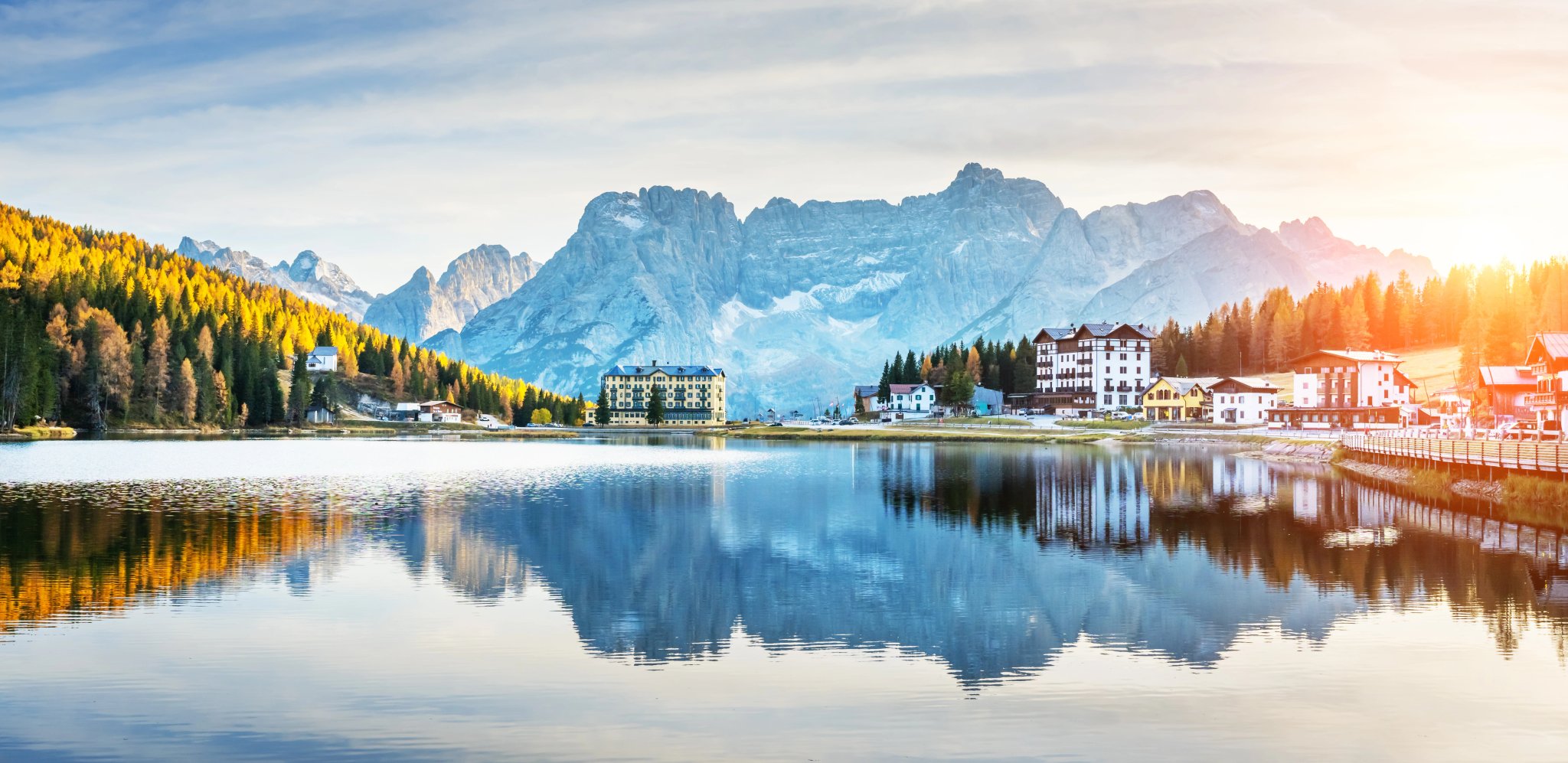
Below is an overview of what to expect in each season so you can plan your Dolomites cycling experience with confidence.
Spring (Late May–June)
Spring arrives late in the Dolomites. Early spring still feels like winter at altitude, but late spring marks the true start of the cycling season. As snow melts through May, the major passes typically begin reopening from late May into early July, depending on snowfall and weather conditions.
Temperatures: 12–22°C in the valleys; 5–15°C at the summits
Best for: Cyclists wanting quieter roads and fresh, clear mountain air
Why ride in late spring:
Many high passes become rideable, often with minimal traffic
Ideal temperatures for long, sustained climbs
Crisp air and excellent visibility for panoramic views
Lush green meadows and vibrant early-season landscapes
Good to know:
Exact pass-opening dates vary yearly
Snow walls may still line the higher roads — spectacular but chilly
Summit cafés and rifugi may open later in the month
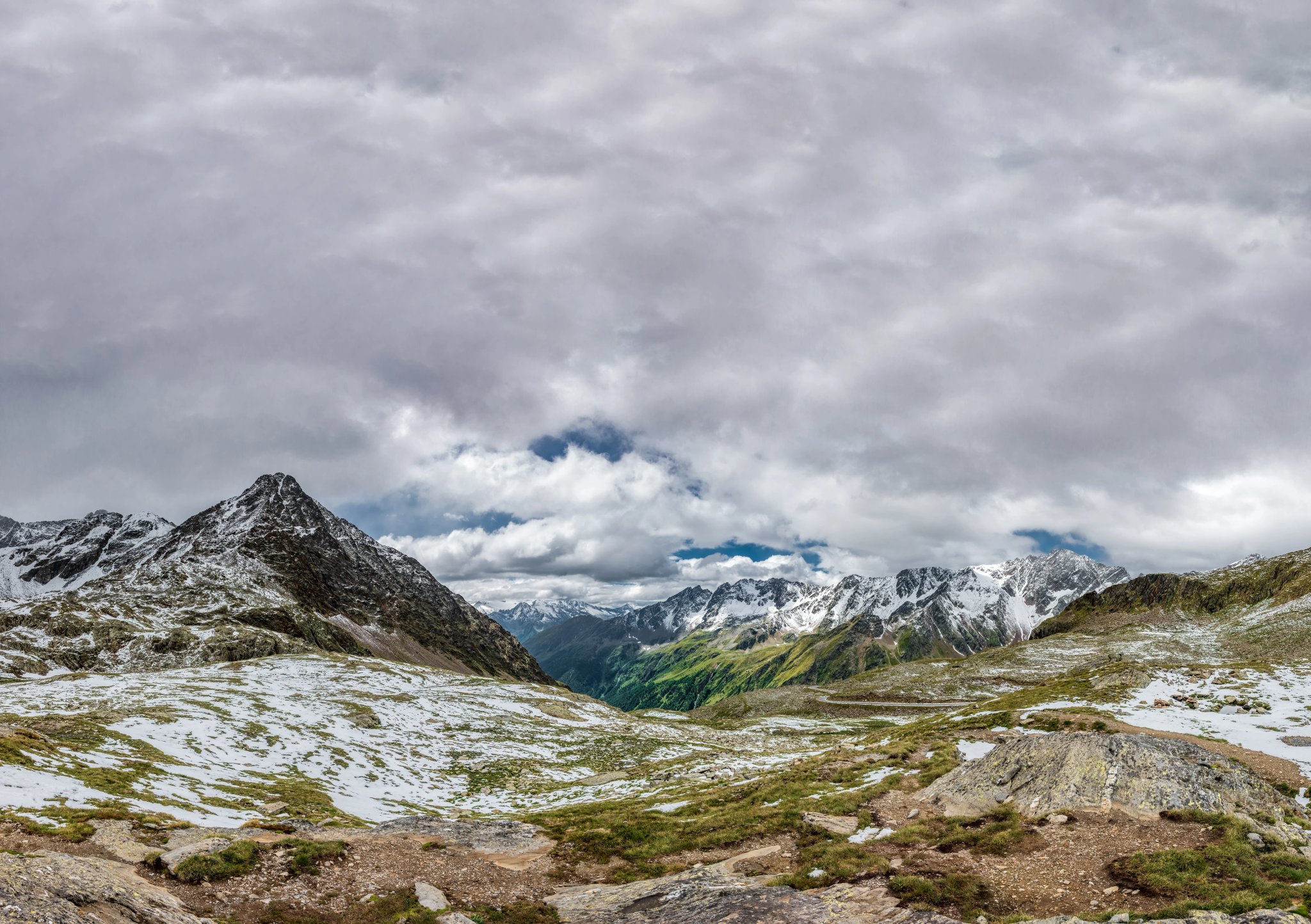
Did you plan to visit Italy in the spring? Consider cycling in southern regions, like Tuscany, Puglia or Sicily & Sardinia, which offer perfect riding conditions this time of the year.
Summer (July–August)
Summer offers the most stable riding conditions and open mountain passes.
All Giro d’Italia passes are open, the roads are clear, and the entire region buzzes with cycling energy. Expect cooler temperatures at altitude even on warm valley days, making climbs comfortable and descents refreshing.
Temperatures: 18–28°C in the valleys; 10–18°C at the summits
Best for: Riders wanting complete access to every legendary pass
Good to know:
Afternoon thunderstorms are possible in July–August
Summit temperatures stay pleasantly cool
Expect more tourists on major passes, especially mid-day
Shoulder weeks (early July and late August) are often ideal
Tip:
If you're cycling during peak summer and prefer cooler roads and fewer people, aim for early morning climbs or plan rides in less tourist-heavy valleys.

Autumn (September–October)
Autumn is often considered the most beautiful time to cycle the Dolomites. The air turns crisp, traffic drops significantly, and the limestone peaks glow gold in the autumn light. September offers stable, warm riding conditions, while October can be magnificent — though snow or early pass closures become increasingly possible.
Temperatures: 10–20°C in September; 5–15°C in October
Best for: Riders seeking quieter roads, dramatic light, and comfortable climbing temperatures
Why ride in autumn:
Calm, stable weather and excellent visibility
Brilliant autumn colours and atmospheric scenery
Perfect conditions for photography and relaxed descents
Fewer crowds and more peaceful passes
Good to know:
Some services begin reducing hours from mid-October
A single snowfall can temporarily close a high pass
Best to check conditions daily later in the season
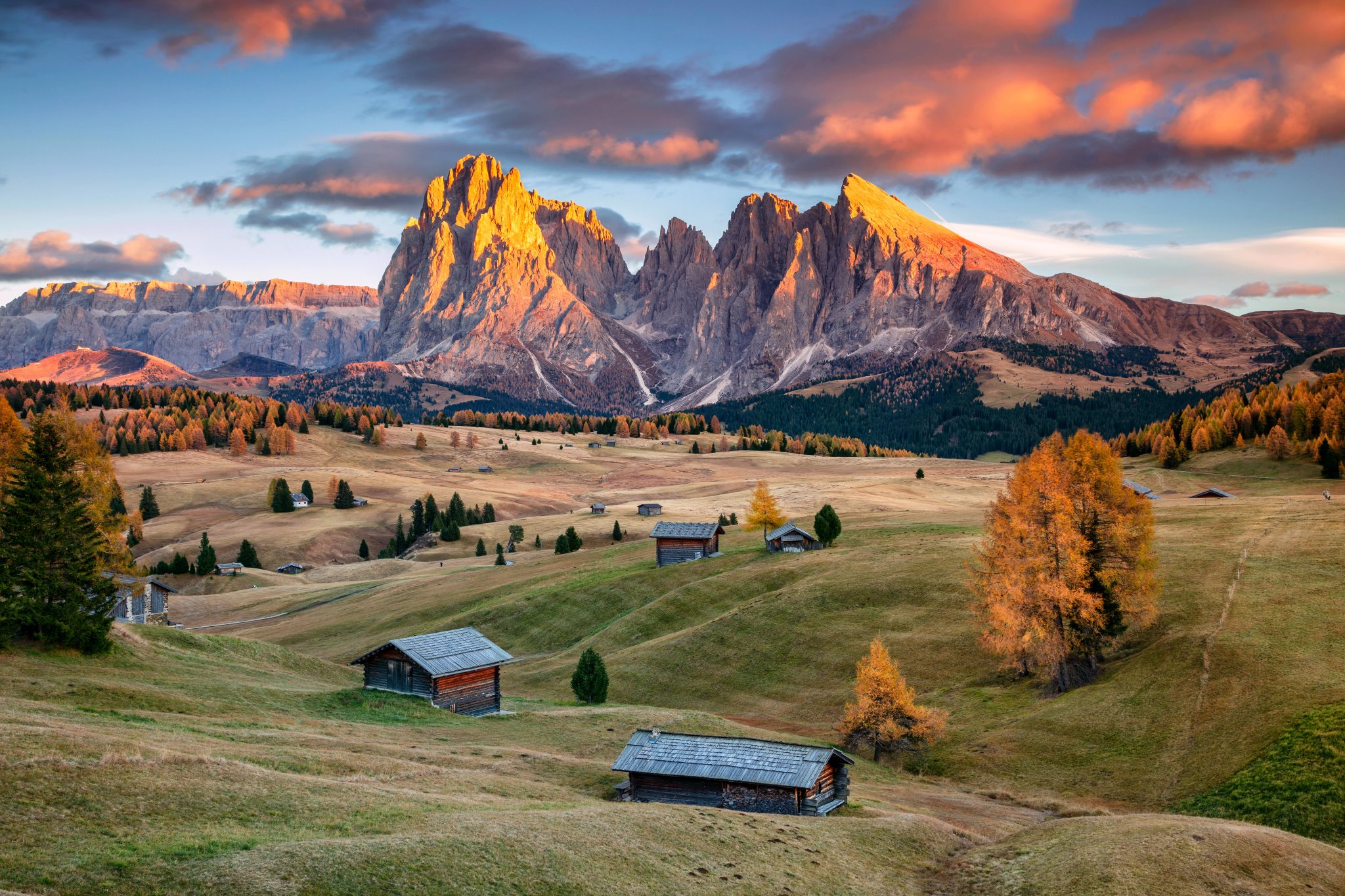
If you decide to cycle the Dolomites in summer, you’ll encounter other active adventures - this region is highly popular among hikers. If you’d like to throw in some hiking days into your itinerary, our hiking tours in the Dolomites are a great for inspiration. Or even better, send us a message and we can recommend the perfect hike to fit your schedule.
Winter (November–April)
Winter transforms the Dolomites into a world-class ski destination — and a non-cycling season. High passes are closed, valley roads are cold and often icy, and conditions are not suitable for road cycling.
If you’re dreaming of a winter cycling escape, we recommend exploring our warm-weather tours in Spain, Portugal, and the Canary Islands, where conditions remain ideal year-round.

Top Cycling Climbs
The Dolomites are home to some of the most exhilarating and iconic climbs in the world — a playground of perfectly engineered switchbacks, smooth tarmac, and dramatic high-mountain scenery.
Giro d’Italia legends rise here in rapid succession, allowing riders to link multiple famous passes in a single tour. From long, steady ascents to short, steep lung-burners, each pass offers its own blend of challenge, beauty, and unforgettable views.
Here are our favorite climbs in the Dolomites:
(AMENITIES Giao, Gavia, Stelvio, Sella, Gardena, Timm….)
Best cycling routes
1. The Cortina Loop Challenge
A stunning introduction to Dolomite riding, this loop starts and ends in Cortina d’Ampezzo, circling through dramatic valleys and rugged alpine scenery. It’s a perfect first taste of the region: challenging, spectacular, and full of classic Dolomites character.
What to Expect
A varied route mixing steady climbs, rolling sections, and alpine viewpoints
Beautiful views of the Tofane and Cristallo massifs
A great warm-up for the bigger passes ahead
Scenic riding without extreme gradients on the first day
Best For
Intermediate to advanced cyclists
Riders wanting an “appetizer” before the major passes
Anyone looking for a memorable but manageable introduction to Dolomite riding
This route is featured in The Ultimate Dolomites Bike Tour and Epic e-Bike Tour (if you prefer a more relaxed cycling), setting the tone for an unforgettable week of world-class cycling.

2. Passo Giau & Passo Falzarego Loop
A legendary Dolomite combination and one of the most dramatic rides you can do. Passo Giau delivers long, steep, uninterrupted climbing, while Falzarego offers high-mountain views and a smoother ascent. Together they form a powerful, unforgettable loop.
What to Expect
One of the steepest iconic climbs in the Dolomites (Giau)
A panoramic, flowing ascent toward Passo Falzarego
Spectacular summit views, perfect for photos
A true queen-stage ride that challenges even strong cyclists
Best For
Strong, experienced riders
Cyclists chasing the Dolomites’ most iconic views
Riders comfortable with sustained steep gradients
You will ride this monumental loop on Day 3 of The Ultimate Dolomites Bike Tour, one of the highlight stages of the entire journey.
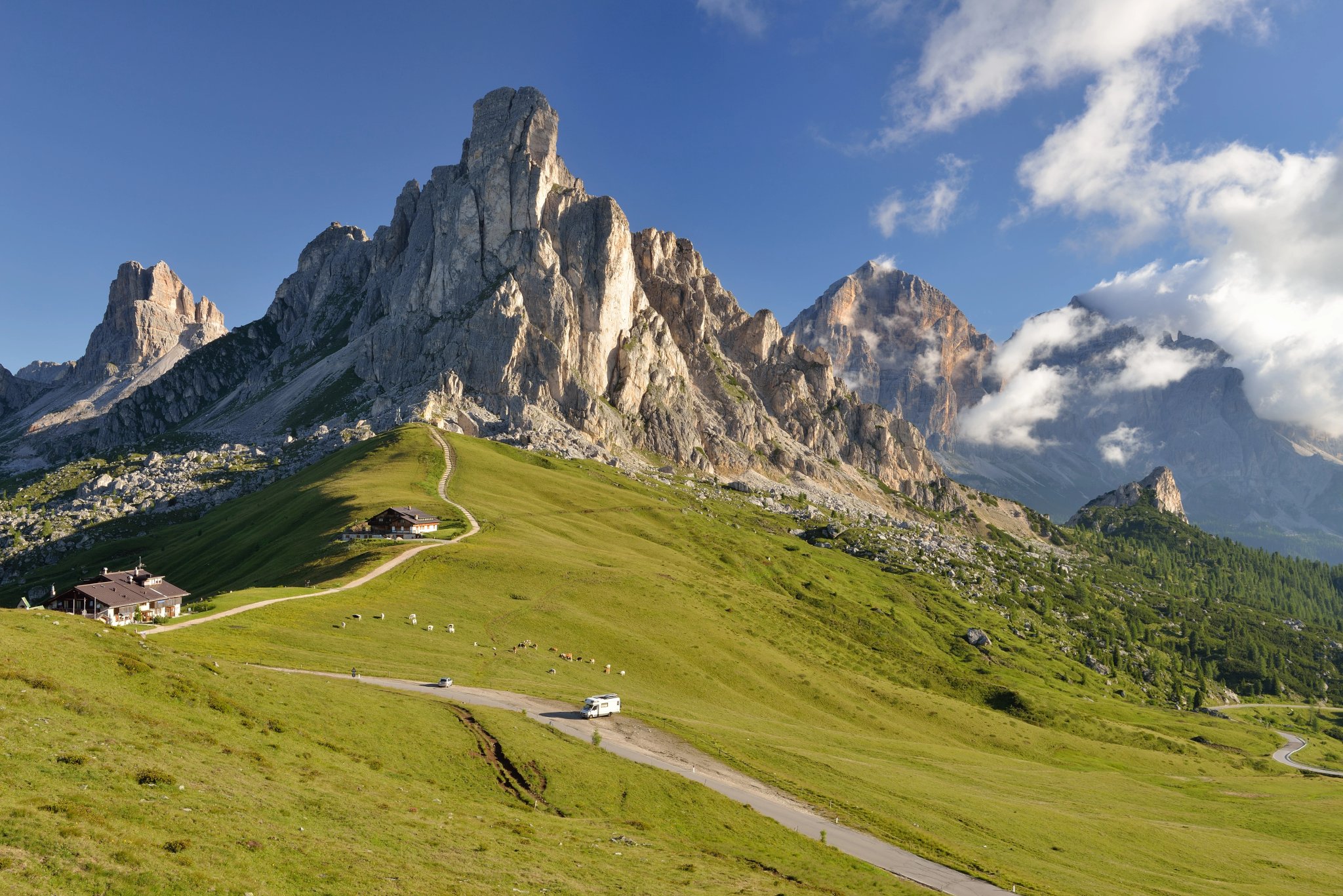
3. Passo Fedaia, Falzarego & the Marmolada Route
A rugged, dramatic, high-alpine ride that takes you beneath the mighty Marmolada Glacier. Passo Fedaia is known for its punishing final ramps, wild scenery, and stunning summit lake, while Falzarego provides a more rhythmic, scenic climb to round out the day.
What to Expect:
Challenging gradients, especially the final Fedaia hairpins
Expansive views of the Marmolada Glacier and Lago di Fedaia
A mix of remote-feeling terrain and iconic Dolomite passes
A hard but incredibly rewarding day in the saddle
Best For:
Advanced climbers
Riders wanting maximum mountain drama
Cyclists seeking quieter, less tourist-heavy climbs
This impressive combination appears on Day 4 of The Ultimate Dolomites Bike Tour, offering one of the most dramatic summit views of the entire week.

4. The Sellaronda Classic
The most iconic loop in the Dolomites — four legendary passes linked together in one flawless circuit: Campolongo, Pordoi, Sella, and Gardena. Smooth switchbacks, perfect gradients, and 360° mountain panoramas make this one of the world’s great cycling experiences.
What to Expect:
Four passes in one continuous, beautifully engineered loop
Breathtaking views of the Sella Massif from every angle
Flowing descents and predictable switchbacks
One of the most rewarding rides a cyclist can do
Best For:
Intermediate to advanced cyclists
Riders looking for an iconic, bucket-list ride
Anyone wanting the quintessential Dolomites experience
This legendary loop forms Day 5 of The Ultimate Dolomites Bike Tour, often described by riders as the single best day of the trip.

If you’d like to explore all of these stunning routes in one unforgettable journey, we’ve combined them into one grand tour of the Dolomites.
5. Passo Stelvio
The undisputed king of the Alps — a legendary ascent with 48 hairpins, high-alpine moonscapes, and one of the most iconic summit finishes in cycling. At 2,757 meters, Stelvio is a rite of passage for every serious rider.
What to Expect:
Endless hairpins and a world-famous serpentine climb
Consistent gradients that reward rhythm and pacing
Dramatic high-alpine terrain and sweeping valley views
A summit that feels like standing on the roof of Europe
Best For:
Strong, experienced climbers
Cyclists chasing a true bucket-list ascent
Anyone wanting to ride one of the most iconic passes in the world
This legendary climb defines Day 2 of the Alpine Pass Challenge Tour, delivering one of the most thrilling and memorable rides you’ll ever experience.
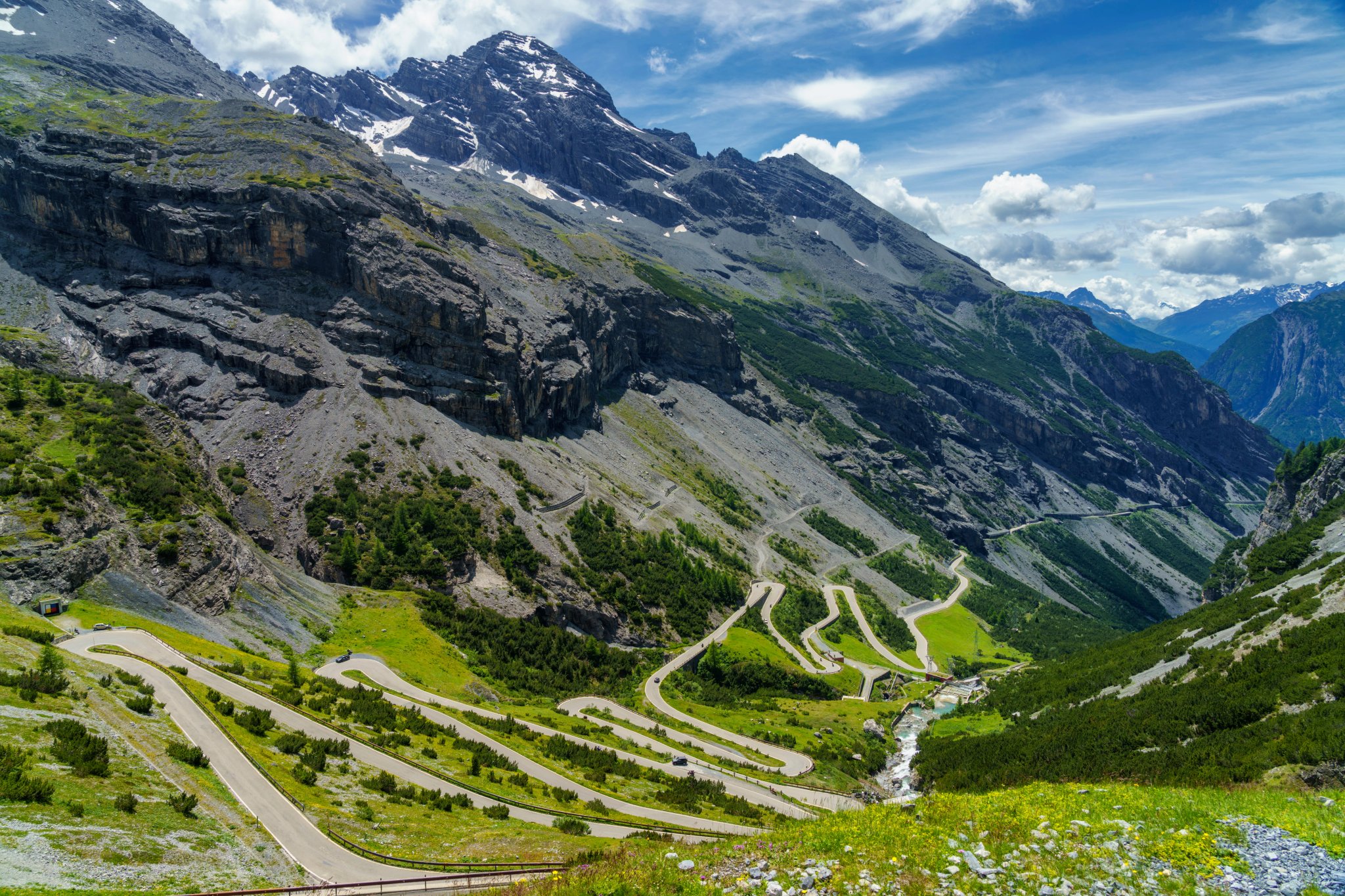
6. Passo Gavia
Wild, rugged, remote — Passo Gavia is one of the most atmospheric climbs in Italy. With steep ramps, narrow roads, and dramatic scenery, it offers a deeper, more intimate alpine experience compared to Stelvio’s grandeur.
What to Expect:
Quiet, narrow mountain roads under towering rock walls
A mix of steep pitches, forest segments, and alpine meadows
Lago Nero and the summit refuge as a reward at the top
A Giro d’Italia classic with a storied past
Best For:
Advanced riders seeking raw, untouched mountain landscapes
Cyclists who enjoy technical climbing and wild terrain
Anyone wanting to experience the Alps beyond the famous icons
This unforgettable ascent is the centerpiece of Day 3 of the Alpine Pass Challenge Tour, offering one of the most dramatic settings of the entire trip.

Suggested Itineraries
1. The Ultimate Dolomites Bike Tour
Passo Gardena – Passo Sella – Passo Pordoi – Passo Campolongo
Ride the most iconic loop in the Dolomites: four legendary passes linked together in a perfectly designed circuit around the majestic Sella Massif. Constant viewpoints, smooth switchbacks, and stunning summit panoramas make this a true bucket-list experience.
Who Is It For?
Intermediate to advanced cyclists
Riders who enjoy steady, sustained climbing
Anyone wanting to experience the essential Dolomites route
Great as a highlight day or centerpiece of any cycling holiday
Types of Bikes: Great for road, touring, e-bike cycling
Suggested Itinerary:
Day 1: Arrival in Cortina
Day 2: The Cortina Loop Challenge
Day 3: Conquering Passo Giau and Passo Falzarego
Day 4: Confronting Passo Fedaia and Revisiting Falzarego
Day 5: The Sellaronda Classic
Day 6: Passo Rolle, Passo San Pellegrino, Passo Valles
Day 7: Passo delle Erbe, Passo Sella, and Gardena
Day 8: Departure

Sounds like your type of ride? We've captured this iconic grand loop is captured in one epic ride:
2. Alpine Pass Challenge
Stelvio – Gavia – Cancano – Mortirolo (optional)
Ride four of the most legendary climbs in the Italian Alps — including the iconic Stelvio, the wild and dramatic Gavia, the hairpin-perfect Laghi di Cancano, and the notoriously steep Mortirolo. This is a concentrated, high-altitude challenge designed for riders who want to experience the raw power and grandeur of the Alps in just a few unforgettable days.
Who Is It For?
Intermediate to advanced climbers
Cyclists who love big passes, big elevation, and big rewards
Riders seeking an intense high-Alpine experience
Anyone wanting to conquer Italy’s most iconic non-Dolomites climbs
Perfect as a standalone trip or as an add-on to a Dolomites cycling holiday
Types of Bikes: Great for road, touring, e-bike cycling
Suggested Itinerary:
Day 1: Laghi di Cancano
Day 2: Passo Stelvio
Day 3: Passo Gavia
Day 4: Departure
Day 5 (Optional): Mortirolo — Extra Challenge Day
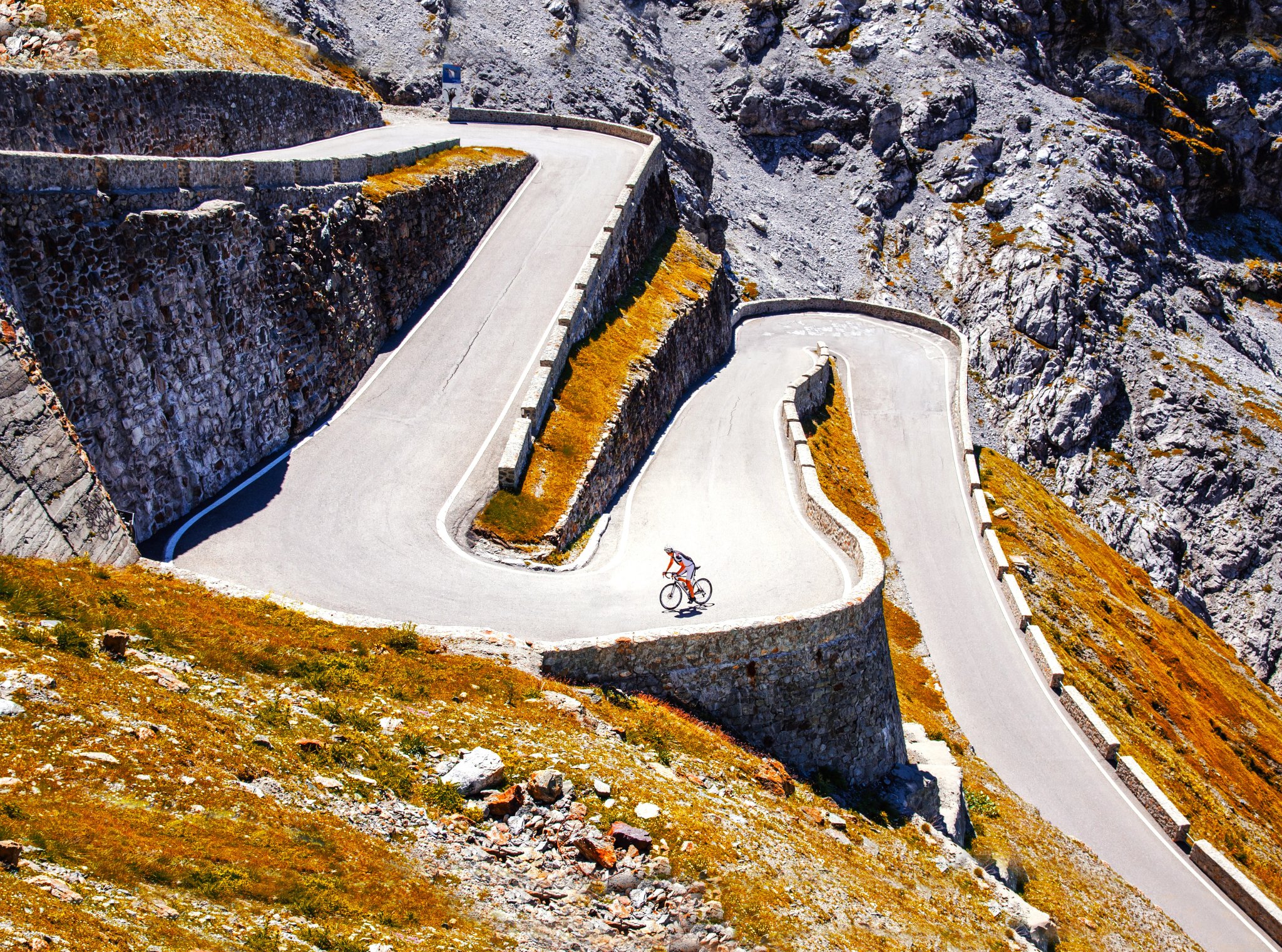
Ready to go? This iconic Alpine trilogy — with the option of the fearsome Mortirolo — is captured in one epic ride:
3. Epic E-Bike Cycling in the Dolomites
Longarone – Cortina – Alta Badia – Predazzo – Valsugana – Bassano del Grappa
Ride one of the most scenic cycling journeys in northern Italy — a point-to-point adventure that starts beneath the dramatic Dolomites and finishes in the historic town of Bassano del Grappa. This E-bike–friendly route blends mountain panoramas, charming valleys, forest roads, and lake-side paths, giving you a wonderfully varied experience across three distinct regions: the Dolomites, Trentino, and Veneto.
Who Is It For?
Leisure to intermediate riders who want a spectacular but approachable cycling vacation
Cyclists who prefer varied landscapes rather than only big climbs
Riders who enjoy a journey-style route with new scenery every day
E-bike travelers looking for a smooth, scenic crossing through northern Italy
Anyone wanting a less intense alternative to the big-pass road cycling tours
Ideal for riders who love scenery, culture, and completing a meaningful A→B adventure.
Suggested Itinerary
Day 1: Arrival in Longarone
Day 2: Longarone → Cortina
Day 3: Cortina Loop
Day 4: Cortina → Alta Badia
Day 5: Alta Badia → Predazzo
Day 6: Predazzo → Torcegno
Day 7: Torcegno → Bassano del Grappa
Day 8: Departure
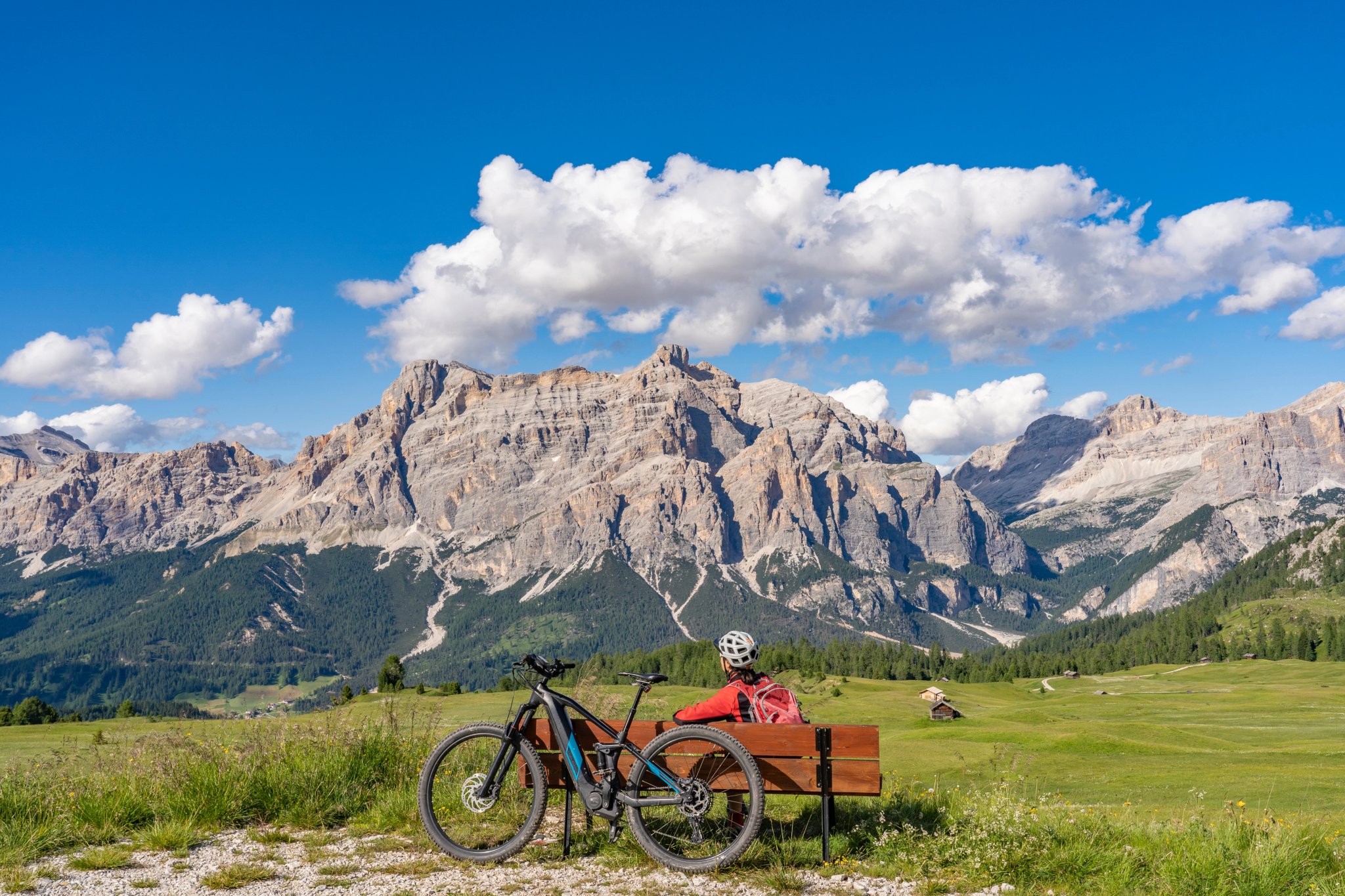
Want to explore the Dolomites by e-bike? This beautifully crafted point-to-point journey showcases the Dolomites, Trentino forests, and Veneto’s historic towns — all designed for easy, enjoyable riding on an E-bike.
Must-See Places
The Dolomites are packed with natural and cultural highlights that add depth to any cycling trip — from iconic passes and panoramic viewpoints to turquoise lakes, alpine villages, and UNESCO-listed landscapes.
Below you’ll find the essential places worth visiting along or near your routes.
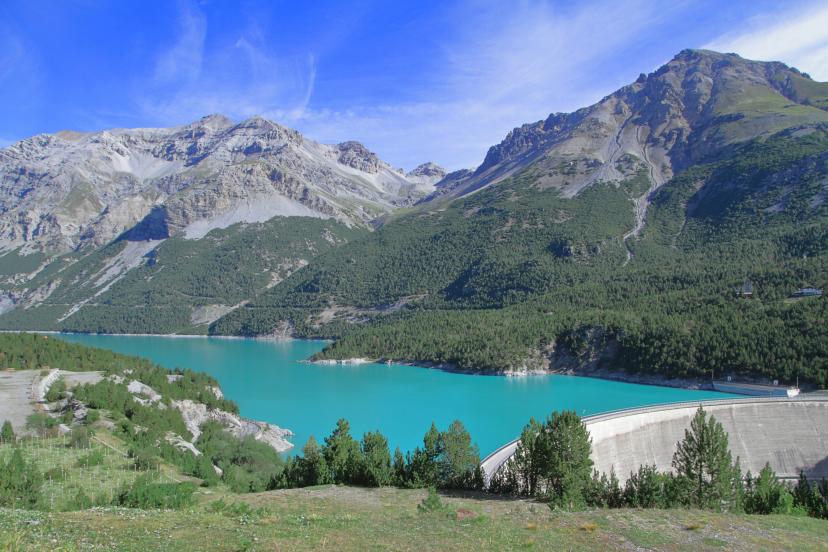
Laghi di Cancano
The twin Cancano Lakes shimmer in shades of turquoise and sapphire in the upper Valtellina valley. Created by two dams in the early 20th century, they blend human engineering with natural splendor. Encircled by peaks and larch forests, the lakes are a gateway to serene alpine paths and a striking contrast to the rugged summits of the Stelvio National Park.
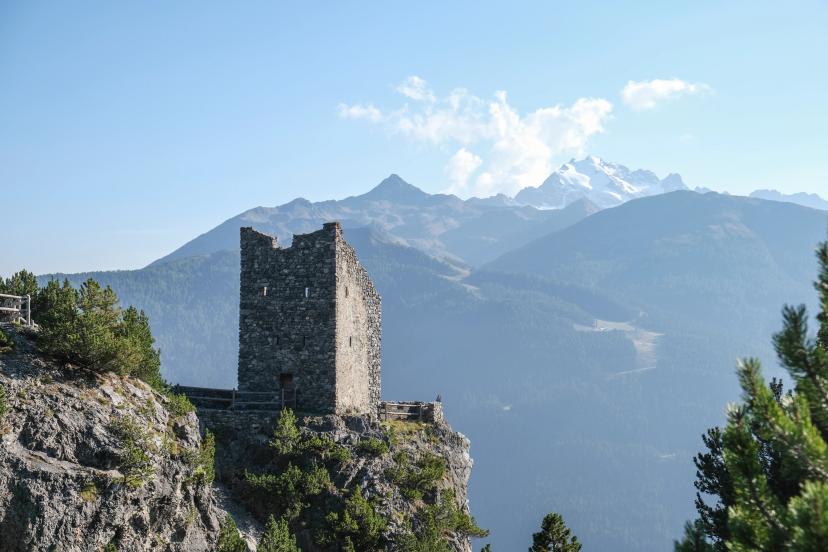
Torri di Fraele
Guarding the entrance to the Cancano valley, the medieval Fraele Towers once formed part of a defensive system controlling access to trade routes through the Alps. Built around the 14th century, their stone silhouettes still stand proudly on the ridge, overlooking the valley below.
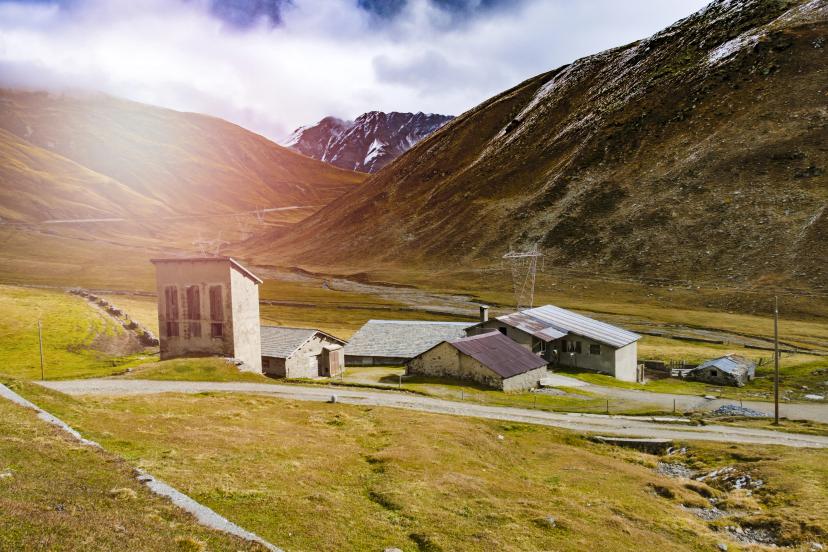
Sacrario Militare dello Stelvio
This solemn military shrine, located at 2,585 meters near the Stelvio Pass, commemorates soldiers who fell during World War I in the harsh alpine battles between Italy and Austria-Hungary. The white stone monument, set against an austere mountain backdrop, contains the remains of over 3,000 soldiers.
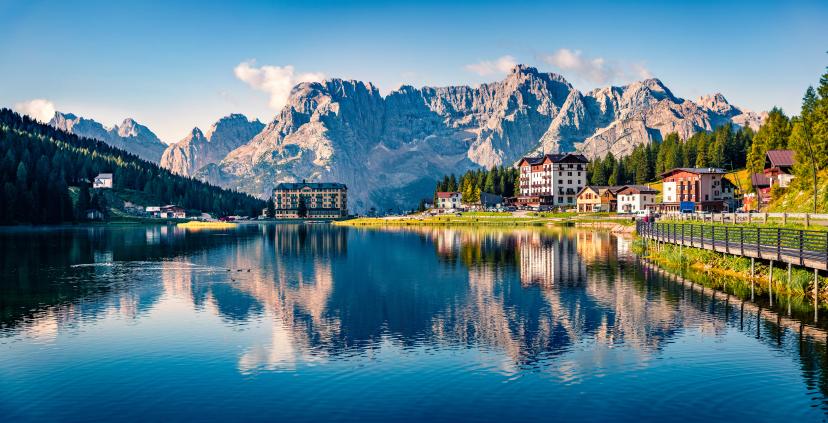
Lake Misurina
Set at 1,754 meters and encircled by majestic peaks, Lake Misurina is often called the “Pearl of the Dolomites.” Its calm, mirror-like waters reflect the Sorapis and Tre Cime di Lavaredo, creating one of Italy’s most photographed alpine scenes. Local legend tells of a spoiled princess turned into the lake itself — her tears forming its depths.

Val di Fassa
Stretching through the heart of the Dolomites, Val di Fassa is a valley of extraordinary natural beauty and cultural richness. Encircled by peaks like the Sella, Catinaccio, and Marmolada, it is a place where Ladin traditions remain alive in language, cuisine, and festivals. Wooden chalets, alpine meadows, and mountain vistas create a landscape that feels both timeless and deeply rooted in local heritage.
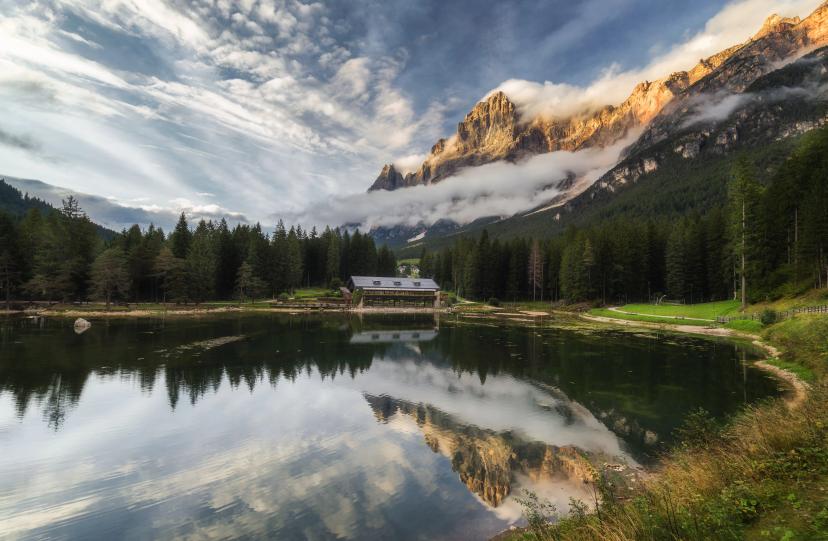
Lake Mosigo
Near San Vito di Cadore lies Lake Mosigo, a small alpine lake surrounded by forested slopes and the dramatic Dolomitic skyline. Known for its crystal-clear reflections and peaceful atmosphere, it’s a favorite spot for walkers and photographers. In calm weather, the mirror-still surface perfectly doubles the peaks above, creating an almost surreal sense of stillness and balance.
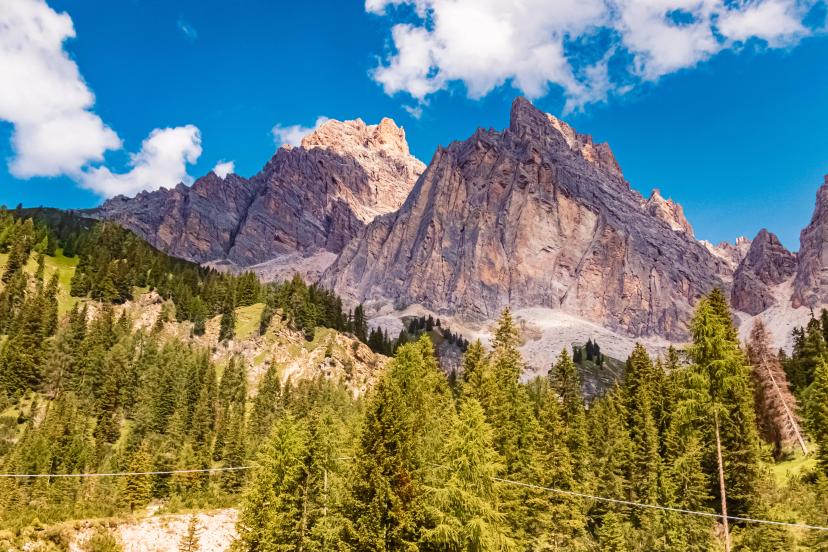
Passo Tre Croci
Connecting Cortina d’Ampezzo with Auronzo di Cadore, the Passo Tre Croci (1,809 m) takes its name from three crosses commemorating a tragic 18th-century story. The pass offers one of the Dolomites’ most breathtaking routes, framed by dense pine forests and vertical limestone cliffs.
Many of the region’s most spectacular viewpoints are only accessible on foot. If you’d like to combine your cycling holiday with a short hike or a hut-to-hut extension, we can easily arrange it. Simply send an inquiry and let us know your preferences.
Cycling Infrastructure
Few mountain regions in Europe are as cyclist-friendly as the Dolomites. Decades of hosting the Giro, granfondos, and cycling tourism have shaped the area into a highly supportive environment for riders.
What makes cycling here especially smooth:
Bike-Friendly Accommodation
Many hotels and guesthouses offer:
Secure bike storage rooms
Basic maintenance tools and pumps
Cleaning stations
Laundry service for cycling kits
Early breakfasts and carb-focused meals
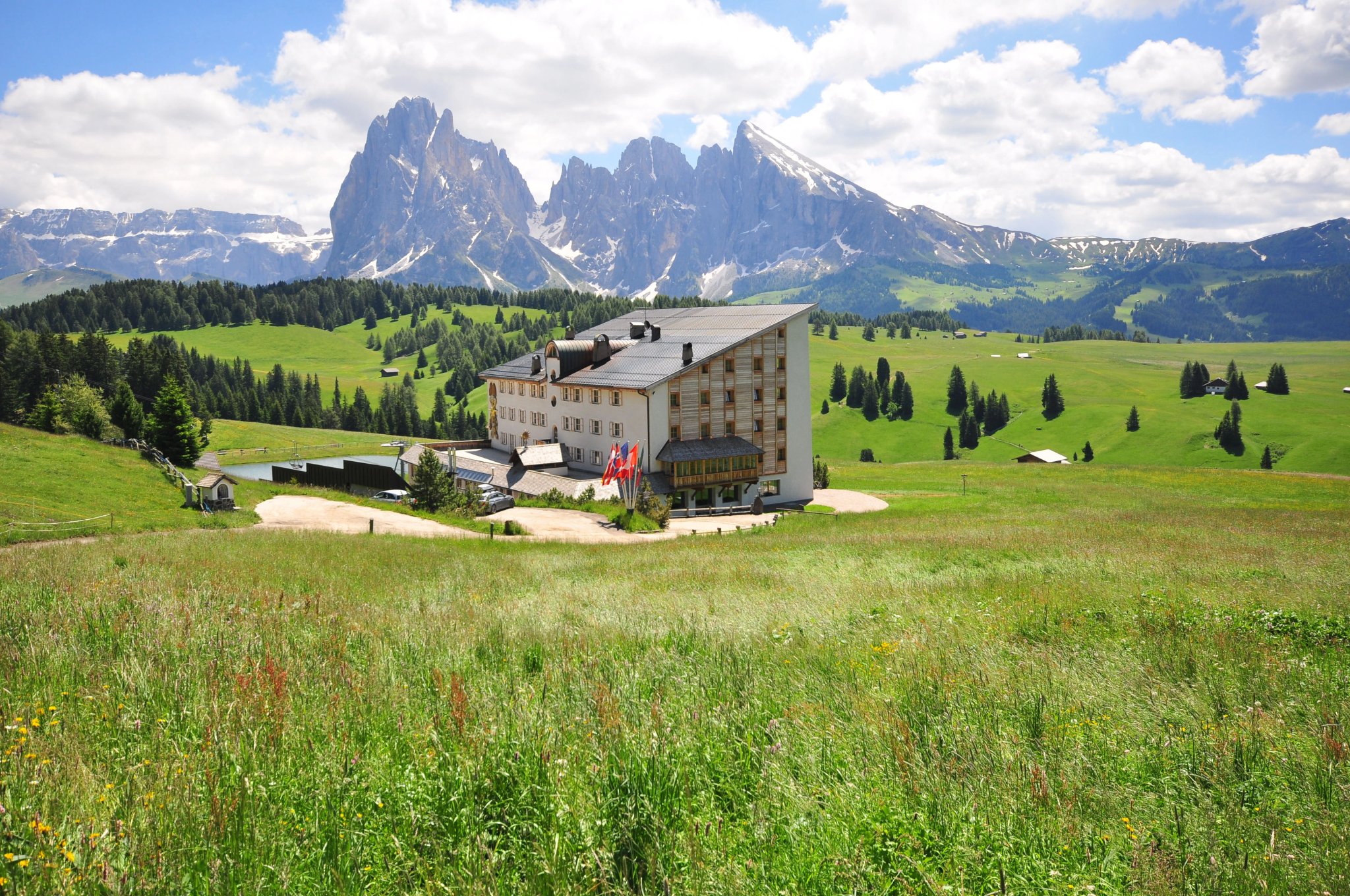
Hotels usually offer locked bike room and basic maintenance tools
Reliable Road Quality
Most passes are resurfaced regularly because they’re Giro stages or major transport routes.
Clear signage, good drainage, and wide hairpins make descending safer and more enjoyable.
Access to Multiple Passes from One Base
Whether you stay in Alta Badia, Val Gardena, Cortina, Arabba, San Martino, or Val di Fassa, you’re usually:
Within riding distance of several major passes
Able to link loops without transfers
Surrounded by well-marked cycling routes
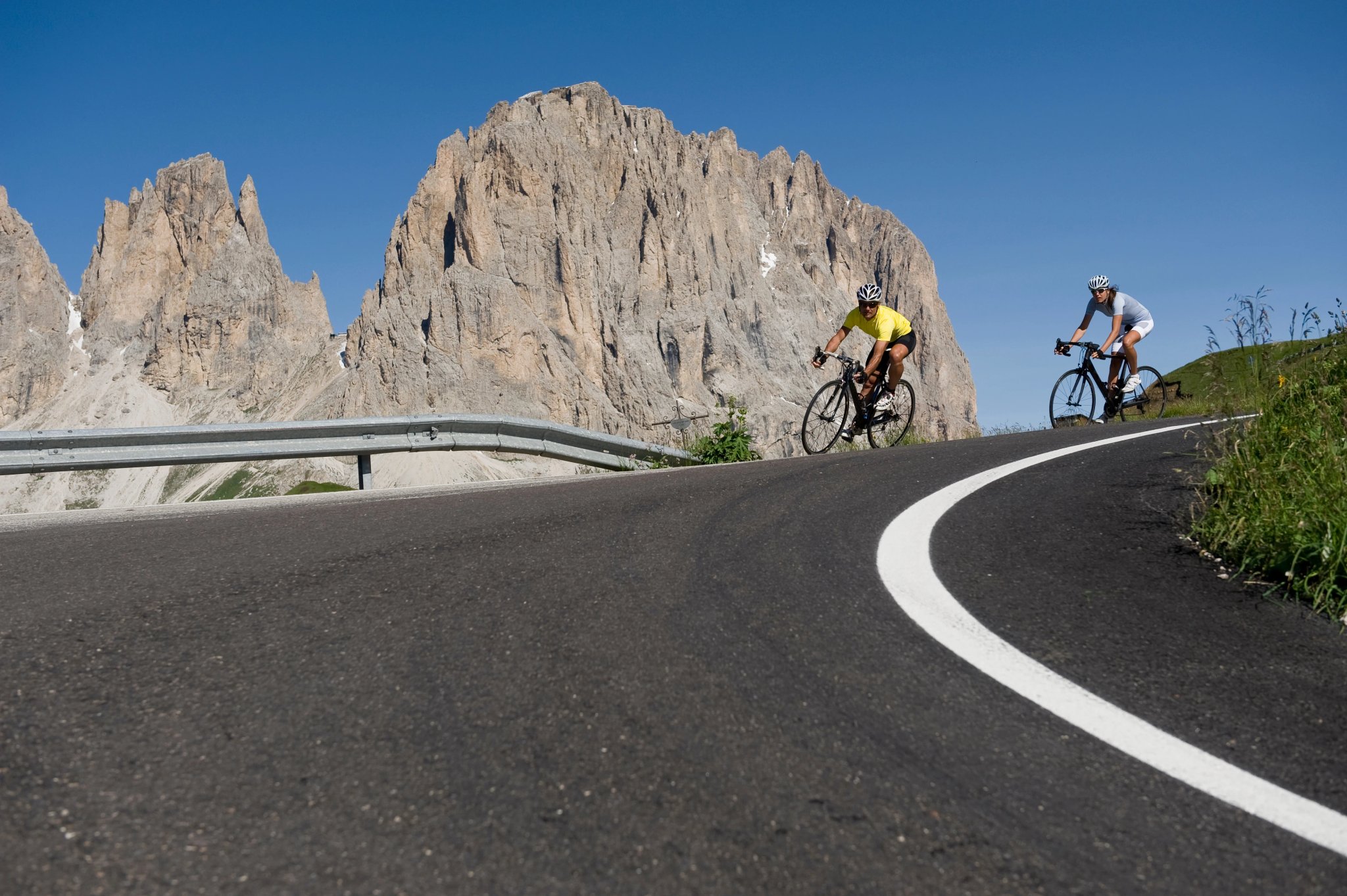
Cycling Events
The Dolomites host some of the most celebrated cycling events in Europe, attracting riders from all over the world. Whether you’re looking for a major challenge, a car-free mountain experience, or a more relaxed community ride, the region offers events for every type of cyclist throughout the season.
These are the most popular ones:
1. Giro d’Italia – Dolomites Stages
Type: Professional WorldTour race (pros only)
When: Every May (3-week race; Dolomites stages vary each year)
What Defines It:
The Giro d’Italia is Italy’s biggest cycling event — one of the three Grand Tours alongside the Tour de France and Vuelta a España. Many of the race’s most iconic and decisive mountain stages take place in the Dolomites, featuring dramatic climbs, historic summit finishes, and unforgettable scenery.

Typical Dolomite Climbs Featured:
Passo Giau
Tre Cime di Lavaredo
Passo Fedaia (Marmolada)
Passo Pordoi
Passo Sella & Gardena
Passo Falzarego & Valparola
Why It’s Special:
Home to some of the most famous climbing battles in Giro history
Brutal gradients and extreme weather possibilities (snow is common!)
Massive crowds on the road and electric atmosphere
Inspires many cyclists to ride the same passes
Who Can Join: Pros only race
Amateur? Don't worry. You can challenge yourself on these tours:
2. Maratona dles Dolomites – Enel
Type: Public granfondo (open to all amateur riders via lottery)
When: Early July
Distance Options:
Maratona Course: ~138 km, ~4,230 m climbing
Middle Course: ~106 km, ~3,130 m climbing
Sellaronda Course: ~55 km, ~1,780 m climbing
What Defines It:
One of the most prestigious amateur cycling events in the world. Riders tackle several legendary passes — Campolongo, Pordoi, Sella, Gardena, Giau, Valparola — all in one day. Around 9,000 participants are selected from tens of thousands of lottery applications.
Who Can Join:
Amateur cyclists (lottery entry required).
Not a professional race.
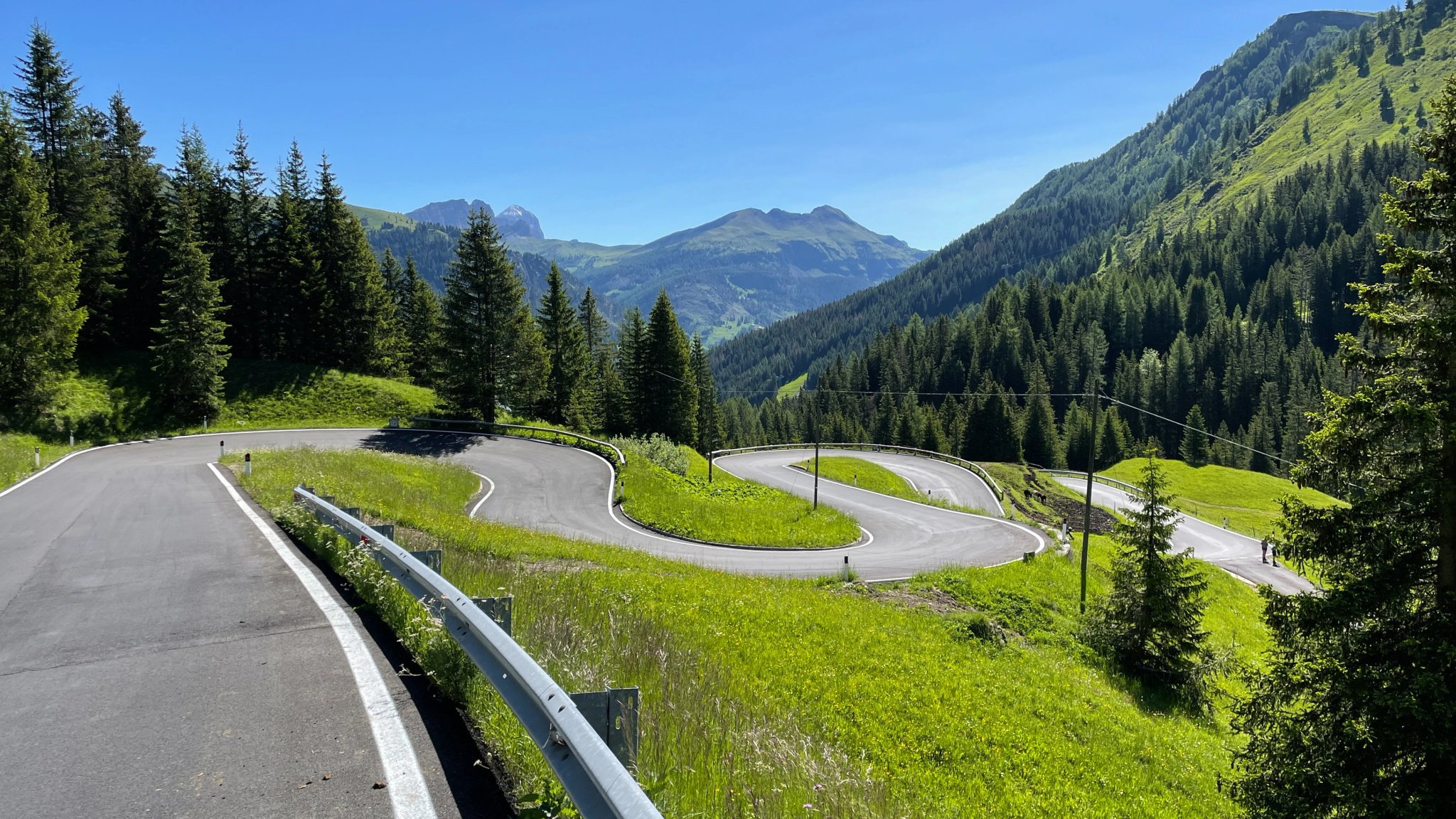
3. Sellaronda Bike Day
Type: Recreational event (open to all — not a race)
When: Two dates each year (June + September)
Distance: ~52–58 km, ~1,600–1,700 m climbing
What Defines It:
A beloved car-free cycling day where the four Sella passes — Campolongo, Pordoi, Sella, Gardena — are completely closed to motor traffic. Thousands of cyclists of every level join with road bikes, MTBs, gravel bikes, and e-bikes.
Who Can Join:
Everyone — families, amateurs, e-bikers, road cyclists.
Zero competition. No registration fee in most years.
You can combine the Sellaronda cycling route with other awesome trails in this week-long cycling holiday.
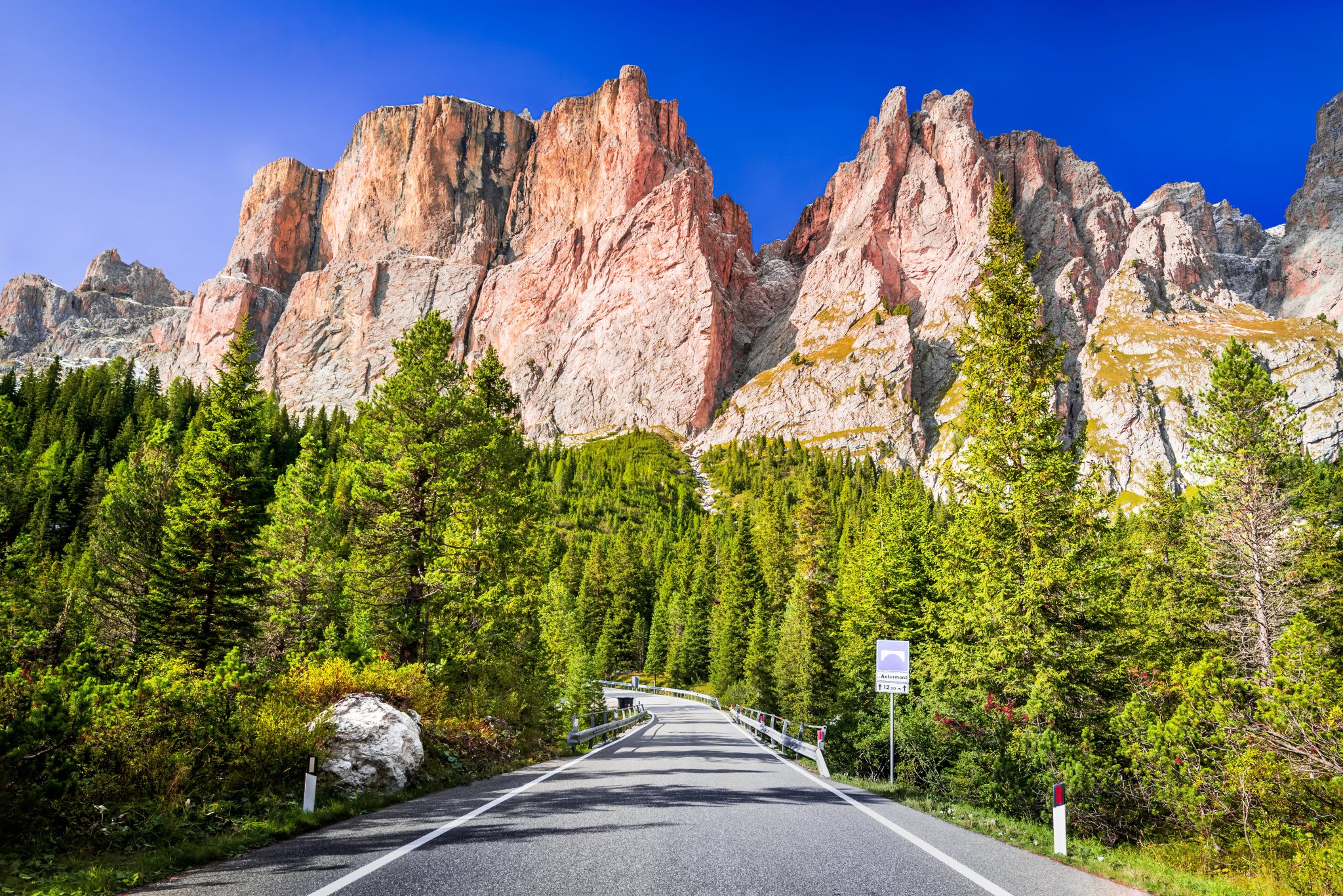
3. Dolomites Bike Day
Type: Recreational, car-free cycling event (open to all)
When: June
Distance: ~51 km, ~1,290 m climbing (approx.)
What Defines It:
Another popular car-free event that closes several historic passes to traffic, including Passo Falzarego, Passo Valparola, and Passo Campolongo. The route touches some of the most scenic roads between Alta Badia, Livinallongo, and Cortina.
Who Can Join:
All cyclists — road bikers, e-bikers, families.
Not a race.
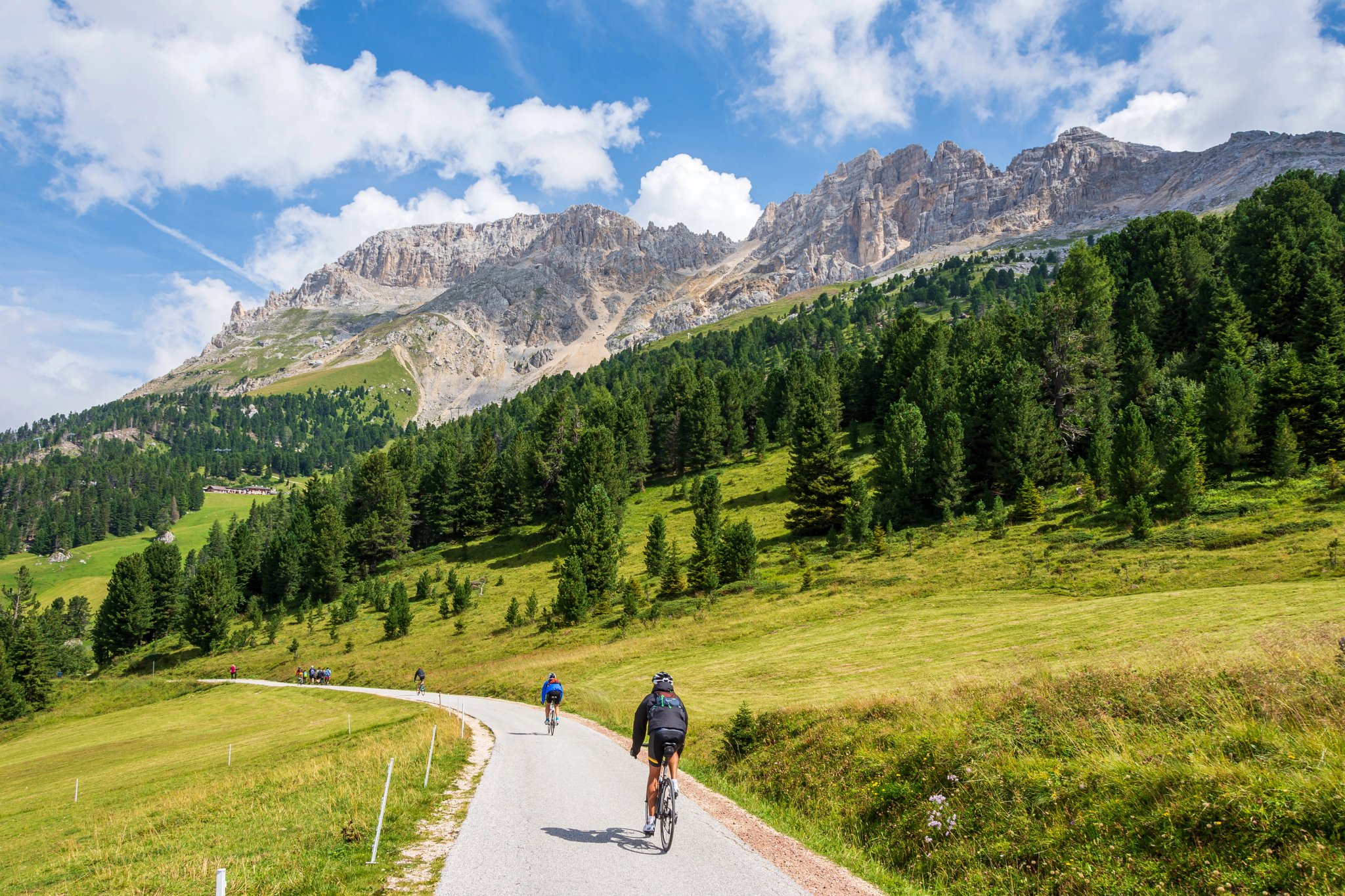
How to Get To/From the Dolomites
Reaching the Dolomites is straightforward thanks to several nearby international airports, reliable public transport, and well-maintained Alpine roads. Below is a quick overview to help travelers plan their arrival and departure smoothly.
Best Base Towns
These are the main cycling hubs in the Dolomites:
Cortina d’Ampezzo
Alta Badia (Corvara / La Villa / Badia)
Predazzo
Longarone
Bassano del Grappa
Closest International Airports
These airports offer the best connections to the Dolomites, depending on your starting point:
1. Venice Marco Polo (VCE)
1.5–2.5 hours to Cortina, Longarone, Alta Badia
Best for most eastern and central Dolomites
2. Treviso (TSF)
2–2.5 hours to Cortina
Popular for low-cost flights
3. Innsbruck (INN), Austria
2 hours to Alta Badia
Excellent option for northern Dolomites and cross-border trips
4. Verona (VRN)
2.5–3 hours to Val di Fiemme, Val di Fassa, Predazzo
Best for western and central Dolomites
5. Milan Bergamo (BGY)
3–4 hours to western and central DOlomites (Alta Badia, Croatia d’Ampezzo, Val di Fassa)
Ideal for combining Dolomites with the Alps (Stelvio, Gavia, Mortirolo)

Public Transport Overview
Public transport in the Dolomites is reliable but varies by valley. Here are the key options and providers to help you plan your transfers smoothly.
By Train
Major railway hubs near the Dolomites:
Calalzo–Pieve di Cadore – for Cortina (connected by Cortina Express)
Bolzano/Bozen – gateway to Val Gardena & Alta Badia
Trento – access point for Val di Fiemme & Valsugana
Belluno – closest to Longarone & eastern Dolomites
Timetables and get tickets: Trenitalia – Italy’s national rail network
Important: Trains do not reach high-altitude towns — final travel is always by bus or private transfer.

Regional train at a station used as a gateway to the Dolomites
By Bus
Main bus providers in the Dolomites:
Cortina Express – Venice ↔ Cortina (seasonal airport + city connections)
ATVO – Venice Marco Polo & Treviso airport shuttles to the Dolomites
Dolomiti Bus – Cadore, Belluno, Longarone, Cortina region
SAD (South Tyrol Transport) – Val Gardena, Alta Badia, Val Pusteria, Bolzano
Good to know:
Direct airport shuttles run seasonally from Venice & Treviso to Cortina.
Local valley buses can be infrequent outside summer.
Many cyclists prefer private transfers for time efficiency and bike handling.
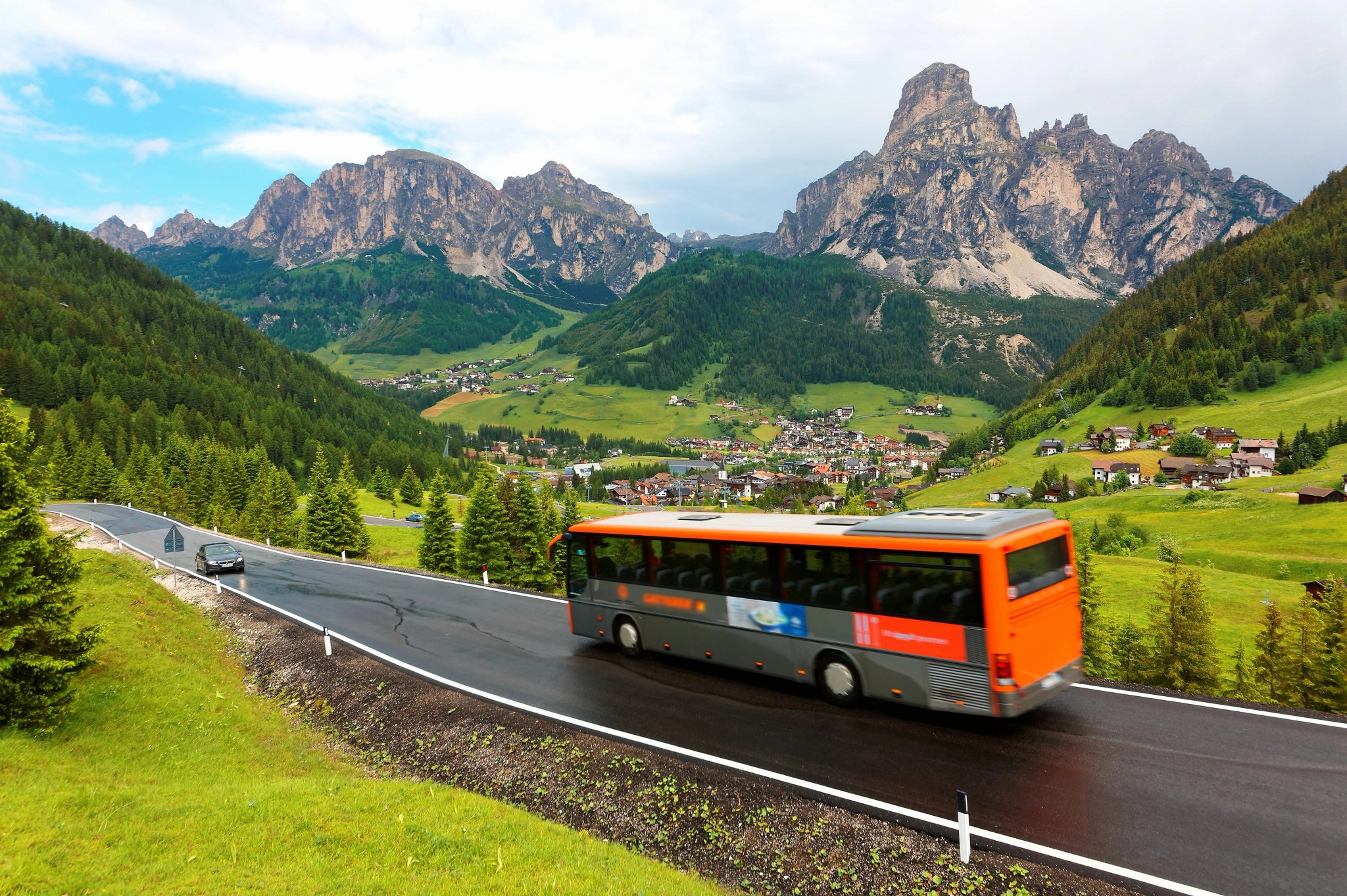
By Car
The most flexible way to travel between Dolomite valleys.
Useful if combining Cortina, Alta Badia, Val di Fassa, or Trentino in one trip.
Parking in high season can be limited in popular towns.
Important:
Many high passes (Giau, Fedaia, Sella, Gardena, Falzarego) may close from November to May depending on snowfall.
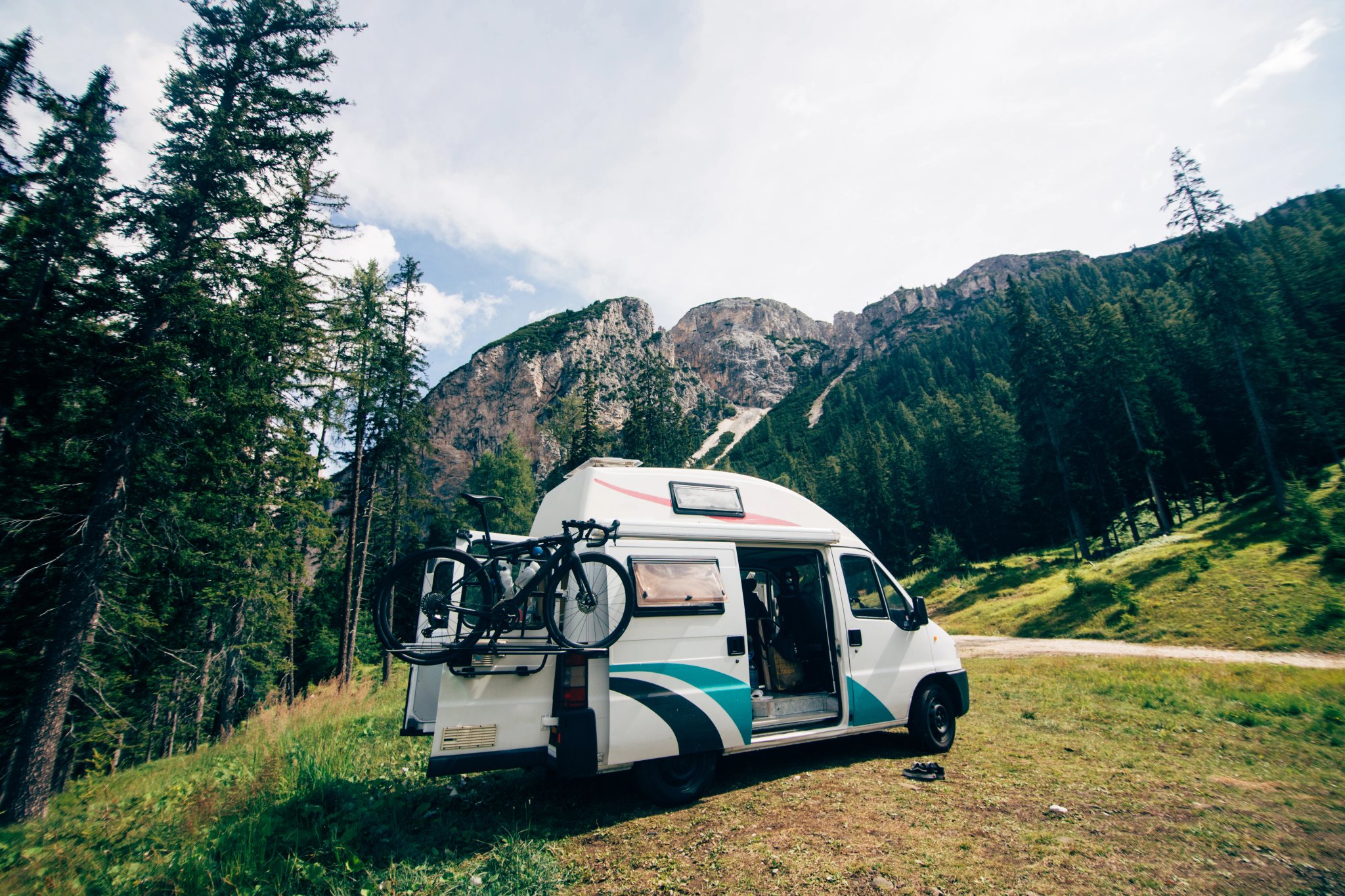
Ride the Dolomites with a Fully Prepared Itinerary
Planning a cycling trip in the Dolomites is possible on your own — but the region’s maze of high passes, remote valleys, and steep mountain roads can make logistics challenging.
That’s where we come in.
Best Cycling Tours
We provide:
Handpicked, cyclist-friendly accommodation
A detailed digital guidebook with daily notes
GPS tracks for every stage
Luggage transfers between bases
Local tips, highlights, and hidden gems along your route
Full support before and during your trip
Send us an inquiry and we’ll help you plan the perfect cycling holiday in the Dolomites.

Hassle-Free
We handle itineraries, accommodations, and anything else you prefer not to deal with, so you can enjoy a carefree holiday.

Completely Customizable
Flexibility is our middle name — whether you want more or less, or just beyond ordinary, we’ll make it happen.

Book with confidence
We are a financially protected company, fully bonded and insured, keeping your money safe and allowing you to travel with confidence.

Unbeatable support
Our 24/7 customer support is where we show our passion, bringing you a better experience by making your well-being our number one priority.



.jpg&w=3840&q=75)
